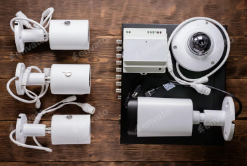Home security cameras are an essential component of modern home security systems, providing peace of mind and protection against potential intruders. Here’s a beginner’s guide to understanding and choosing home security cameras.
1. Types of Home Security Cameras
- Wired Cameras: These cameras require a physical connection to a power source and a recording device. They are often more reliable in terms of connection quality.
- Wireless Cameras: These use Wi-Fi for connectivity and can be placed anywhere without the need for cables. They are easy to install but rely on battery power or a consistent power source.
- Indoor vs. Outdoor Cameras:
- Indoor Cameras are generally smaller and less robust against weather.
- Outdoor Cameras are designed to withstand the elements and often feature night vision.
2. Key Features to Consider
- Resolution: Higher resolution (1080p, 4K) provides clearer images, making it easier to identify faces or details.
- Field of View: A wider field of view allows you to cover more area with a single camera.
- Night Vision: Essential for viewing in low-light conditions, infrared night vision is a common feature.
- Motion Detection: Cameras with motion sensors can send alerts when movement is detected.
- Two-Way Audio: Allows you to communicate with someone through the camera, useful for security or monitoring pets.
- Cloud Storage vs. Local Storage: Decide if you want to save footage on a cloud service (which often involves a subscription) or on a local device like an NVR (network video recorder).
3. Installation Tips
- Placement: Consider areas to monitor, such as entry points, backyards, or common areas. Install cameras high enough to avoid tampering.
- Wi-Fi Strength: For wireless cameras, ensure there’s a strong Wi-Fi signal where you place the camera.
- Accessibility: Ensure you can easily access camera controls and features for connection and maintenance.
4. Privacy Considerations
- Legal Compliance: Be aware of privacy laws regarding video recording in your area, especially if filming public spaces. Informing visitors about surveillance can also be a good practice.
5. Keeping Your System Secure
- Change Default Passwords: Always change default usernames and passwords to avoid unauthorized access.
- Regular Updates: Keep the camera firmware and software updated to protect against vulnerabilities.
- Secure Your Network: Use strong passwords and consider a separate network for your security devices.
Selecting and setting up home security cameras can significantly enhance your home’s safety. By understanding the types, features, and installation best practices, you can create a security system that meets your needs and provides peace of mind.
